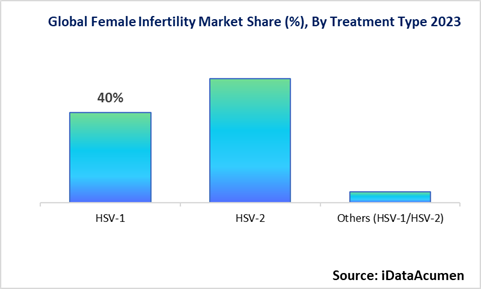Genital Herpes Market Expected to Achieve US$ 7.1 Bn by 2030 | CAGR 4.5%
Global Genital Herpes Market is expected to reach US$ 7.1 Bn in 2030 with a growth rate of 4.5%. Genital herpes is a common sexually transmitted infection caused by the herpes simplex virus (HSV), resulting in painful genital sores. Rising prevalence of genital herpes globally is a major factor driving market growth.
According to WHO estimates, around 536 million people aged 15-49 years were living with HSV-2 infection globally in 2020. In the US, around 1 in 8 people have genital herpes. High disease burden across regions provides significant opportunities for treatment and diagnostics. Advancements in rapid diagnostic tests like PCR and point-of-care assays allow quick and accurate diagnosis, aiding market growth.
The genital herpes market is also driven by a strong product pipeline. Multiple novel antiviral drugs like pritelivir, ASP2151 etc. and vaccine candidates are in the pipeline, which upon approval will expand treatment options. Strategic collaborations between pharmaceutical companies are accelerating drug development. Favorable government initiatives to promote sexual health and reduce STIs prevalence are also supporting market growth.
However, the social stigma associated with STIs and long clinical trial timelines pose challenges for growth. Nevertheless, rising adoption of OTC medications and direct-to-consumer testing presents opportunities. Integration of digital health technologies like telehealth and patient monitoring apps will also enable better disease management. North America is the largest regional market due to high disease prevalence, followed by Europe. Asia Pacific is expected to witness the fastest growth over the forecast period.

Drivers:
- Rising prevalence of genital herpes infections globally is a major factor driving the market growth. As per WHO, around 536 million people aged 15-49 years were living with HSV-2 infection globally in 2020.
- Technological advancements in diagnostic techniques like rapid point-of-care tests and improvements in PCR are contributing to market growth by enabling early diagnosis.
Trends:
- Strategic partnerships between pharmaceutical companies are accelerating drug development through combined expertise.
- Integration of digital health technologies like telehealth and patient monitoring apps will enable better disease management.
Opportunity:
- Favorable government initiatives to promote sexual health and reduce STIs prevalence support market growth through policies aimed at improved screening access and counseling.
Key Report Insights:
- North America accounted for over 40% market share in 2022 and is expected to dominate during the forecast period. Prominent companies like Merck, GSK, and Abbott have a strong presence in the region. High disease prevalence and awareness are key drivers in North America.
- Europe accounted for over 25% market share in 2022 and is poised to be the second largest market. GSK, Roche, and BioMerieux are leading players in Europe. Rising awareness about STIs is driving growth in the region.
- Leading companies operating in the global genital herpes market include GlaxoSmithKline, Merck, Abbott, BD, Roche, Thermo Fisher Scientific, Danaher, Hologic, Diasorin, and Siemens Healthineers. These players have a global presence and comprehensive product portfolios.
Genital Herpes Market Segmentation:
- By Type
- HSV-1
- HSV-2
- Others (HSV-1/HSV-2)
- By Drug Class
- Nucleoside analogues
- Non-nucleoside polymerase inhibitors
- Helicase-primase inhibitors
- Others
- By Route of Administration
- Oral
- Topical
- Injectable
- Others
- By Distribution Channel
- Hospital Pharmacies
- Retail Pharmacies
- Online Pharmacies
- Others
- By Regions
- North America
- U.S.
- Canada
- Europe
- Germany
- U.K.
- Spain
- France
- Italy
- Russia
- Rest of Europe
- Asia Pacific
- China
- India
- Japan
- Australia
- South Korea
- ASEAN
- Rest of Asia Pacific
- Latin America
- Brazil
- Argentina
- Mexico
- Rest of Latin America
- Middle East & Africa
- GCC Countries
- Israel
- South Africa
- North Africa
- Central Africa
- Rest of the Middle East
- North America
Definition:
“Genital herpes refers to a common sexually transmitted disease caused by the herpes simplex virus (HSV). It results in painful sores and blisters in the genital area. There are two types of herpes simplex virus - HSV-1 and HSV-2. HSV-2 is primarily responsible for causing genital herpes. Transmission occurs through direct skin-to-skin contact with infected secretions during oral, vaginal or anal sex. Once infected, the virus remains lSatent in the body and can get reactivated to cause recurrent outbreaks triggered by stress, illness, fatigue etc. Antiviral medications can help shorten the duration and frequency of outbreaks. Condom use also helps lower transmission risk. There is no cure for genital herpes, but controlling symptoms is important to reduce complications and transmission to partners.”